Projects
Human Papillomavirus antibodies and risk of subsequent head and neck cancer
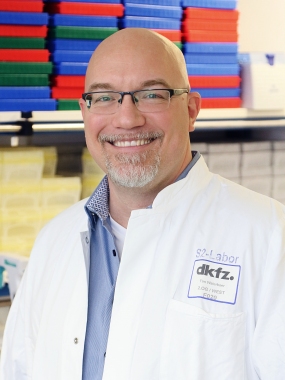
Dr. Tim Waterboer
© DKFZ/Jung
HPV is known for causing cervical cancer, but it also causes large proportions of other anogenital cancers (anal, vaginal, vulva, penis) and head and neck, especially oropharyngeal cancer (OPC), i.e. cancer of the palatine tonsils and the base of tongue.
OPC is rare, but shows strongly increasing incidence rates in many countries. The "classical" risk factors tobacco and alcohol have been superseded by HPV in the US and some European countries (e.g. UK, Sweden), where more than 70% of OPC are attributable to HPV, predominantly type 16 (HPV16). In these countries, the number of men with HPV-driven OPC (HPV-OPC) already exceeds the number of women with cervical cancer. This is a paradigm shift for HPV, and requires entirely new public health interventions, given HPV vaccination is currently largely unavailable for boys. Although HPV-OPC is characterized by favorable survival, diagnosis typically occurs after the primary tumor has metastasized to the neck, often necessitating the use of multimodality treatment which may result in severe treatment related morbidity, such as speech and swallowing dysfunction, feeding tube dependence, and facial disfigurement. To date, no precursor lesion for OPC has been identified rendering early detection challenging.
Serum antibodies against HPV16 proteins, especially the oncoprotein E6, are promising biomarkers for identifying individuals at risk for HPV-OPC development. HPV16 E6 antibodies have been shown to be present in approximately 90% of HPV-OPC patients at the time of diagnosis, with a specificity of 99%, and are detectable more than ten years prior to diagnosis. HPV16 E6 seroprevalence in the general population and in cancer-free controls is about 0.5%, rendering HPV16 E6 seropositivity a promising foundation to develop an efficient screening strategy for early detection of HPV-OPC. The 5-year risk of a 60-year old HPV16 E6 seropositive male in the US to develop HPV-OPC has been estimated at >25%, corresponding to a positive predictive value (PPV) exceeding that of established screening methods for e.g. cervical, breast or colorectal cancer.
We have recently completed the first proof of principle HPV16 E6 serology-based screening study for HPV-OPC in a population-based setting embedded in the Hamburg City Health Study (HCHS). We measured serum antibodies against HPV16 early proteins (E6, E1, E2, E7) in the first 5,000 HCHS participants, and identified eleven individuals with a high-risk HPV16 antibody profile for the development of HPV-OPC. These individuals were monitored with regular, non-invasive head and neck exams every six months. Within 1.3 years of clinical follow-up, three individuals were diagnosed with asymptomatic stage I HPV-OPC. This is the world's largest and most successful study of its kind.
1. Kreimer AR, Johansson M, Waterboer T, Kaaks R, Chang-Claude J, Drogen D, Tjønneland A, Overvad K, Quirós JR, González CA, Sánchez MJ, Larrañaga N, Navarro C, Barricarte A, Travis RC, Khaw KT, Wareham N, Trichopoulou A, Lagiou P, Trichopoulos D, Peeters PH, Panico S, Masala G, Grioni S, Tumino R, Vineis P, Bueno-de-Mesquita HB, Laurell G, Hallmans G, Manjer J, Ekström J, Skeie G, Lund E, Weiderpass E, Ferrari P, Byrnes G, Romieu I, Riboli E, Hildesheim A, Boeing H, Pawlita M, Brennan P. Evaluation of human papillomavirus antibodies and risk of subsequent head and neck cancer. J Clin Oncol. 2013 Jul 20;31(21):2708-15.
2. Kreimer AR, Johansson M, Yanik EL, Katki HA, Check DP, Lang Kuhs KA, Willhauck-Fleckenstein M, Holzinger D, Hildesheim A, Pfeiffer R, Williams C, Freedman ND, Huang WY, Purdue MP, Michel A, Pawlita M, Brennan P, Waterboer T. Kinetics of the Human Papillomavirus Type 16 E6 Antibody Response Prior to Oropharyngeal Cancer. J Natl Cancer Inst. 2017 Aug 1;109(8):djx005.
3. Kreimer AR, Ferreiro-Iglesias A, Nygard M, Bender N, Schroeder L, Hildesheim A, Robbins HA, Pawlita M, Langseth H, Schlecht NF, Tinker LF, Agalliu I, Smoller SW, Ness-Jensen E, Hveem K, D'Souza G, Visvanathan K, May B, Ursin G, Weiderpass E, Giles GG, Milne RL, Cai Q, Blot WJ, Zheng W, Weinstein SJ, Albanes D, Brenner N, Hoffman-Bolton J, Kaaks R, Barricarte A, Tjønneland A, Sacerdote C, Trichopoulou A, Vermeulen RCH, Huang WY, Freedman ND, Brennan P, Waterboer T, Johansson M. Timing of HPV16-E6 antibody seroconversion before OPSCC: findings from the HPVC3 consortium. Ann Oncol. 2019 Aug 1;30(8):1335-1343.
4. Hibbert J, Halec G, Baaken D, Waterboer T, Brenner N. Sensitivity and Specificity of Human Papillomavirus (HPV) 16 Early Antigen Serology for HPV-Driven Oropharyngeal Cancer: A Systematic Literature Review and Meta-Analysis. Cancers (Basel). 2021 Jun 16;13(12):3010.
5. Brenner N, Mentzer AJ, Hill M, Almond R, Allen N, Pawlita M, Waterboer T. Characterization of human papillomavirus (HPV) 16 E6 seropositive individuals without HPV-associated malignancies after 10 years of follow-up in the UK Biobank. EBioMedicine. 2020 Dec;62:103123.
6. Robbins HA, Ferreiro-Iglesias A, Waterboer T, Brenner N, Nygard M, Bender N, Schroeder L, Hildesheim A, Pawlita M, D'Souza G, Visvanathan K, Langseth H, Schlecht NF, Tinker LF, Agalliu I, Wassertheil-Smoller S, Ness-Jensen E, Hveem K, Grioni S, Kaaks R, Sánchez MJ, Weiderpass E, Giles GG, Milne RL, Cai Q, Blot WJ, Zheng W, Weinstein SJ, Albanes D, Huang WY, Freedman ND, Kreimer AR, Johansson M, Brennan P. Absolute Risk of Oropharyngeal Cancer After an HPV16-E6 Serology Test and Potential Implications for Screening: Results From the Human Papillomavirus Cancer Cohort Consortium. J Clin Oncol. 2022 Nov 1;40(31):3613-3622.
7. Busch CJ, Hoffmann AS, Viarisio D, Becker BT, Rieckmann T, Betz C, Bender N, Schroeder L, Hussein Y, Petersen E, Jagodzinski A, Schäfer I, Burandt E, Lang Kuhs K, Pawlita M, Waterboer T, Brenner N. Detection of stage I HPV-driven oropharyngeal cancer in asymptomatic individuals in the Hamburg City Health Study using HPV16 E6 serology - A proof-of-concept study. EClinicalMedicine. 2022 Sep 17;53:101659.
Serology-based screening for HPV-driven oropharyngeal cancer
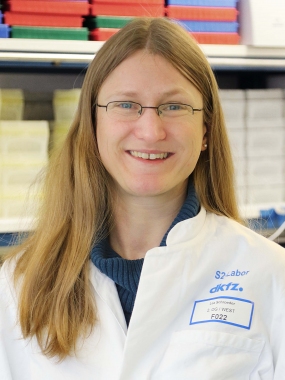
Lea Schroeder
© DKFZ/Jung
The incidence of oropharyngeal cancer attributable to human papillomaviruses (HPV-OPC) has been rising constantly over the last decades. How oral HPV infections progress into cancer is poorly understood due to the lack of detectable precancerous lesions, making early detection of HPV-OPC difficult. Antibodies to HPV16 early proteins, especially E6, are strongly associated with HPV-OPC at the time of, but also prior to diagnosis1,2.
Within the Hamburg City Health Study (HCHS), a prospective, epidemiologic cohort study, we measured HPV serum antibodies in the first 5,000 participants (men and women of the general population of the city of Hamburg aged 45-74 years, enrolled 2016-2017) and identified eleven individuals with a high-risk profile for the development of HPV-OPC. These individuals were invited to regular 6-monthly, non-invasive head and neck examinations to diagnose HPV-OPC as early as possible. In this proof-of-concept study, three individuals were diagnosed with asymptomatic stage I HPV-OPC within 1.3 years of clinical follow-up3. We are currently extending this screening approach to the next 10,000 HCHS participants enrolled 2017-2020 ("PHORECAST" – Hamburg HPV Oropharyngeal Cancer Screening Study), with additional clinical examinations and a more comprehensive panel of biomarkers in order to describe the combination that maximizes the positive predictive value for HPV-OPC. HPV serology-based screening may facilitate early detection of HPV-OPC and thus reduce treatment-related morbidity. Furthermore, this study may also enable us to identify and characterize precancerous lesions of HPV-OPC.
1. Kreimer AR, Johansson M, Waterboer T, Kaaks R, Chang-Claude J, Drogen D, Tjønneland A, Overvad K, Quirós JR, González CA, Sánchez MJ, Larrañaga N, Navarro C, Barricarte A, Travis RC, Khaw KT, Wareham N, Trichopoulou A, Lagiou P, Trichopoulos D, Peeters PH, Panico S, Masala G, Grioni S, Tumino R, Vineis P, Bueno-de-Mesquita HB, Laurell G, Hallmans G, Manjer J, Ekström J, Skeie G, Lund E, Weiderpass E, Ferrari P, Byrnes G, Romieu I, Riboli E, Hildesheim A, Boeing H, Pawlita M, Brennan P. Evaluation of human papillomavirus antibodies and risk of subsequent head and neck cancer. J Clin Oncol. 2013 Jul 20;31(21):2708-15.
2. Kreimer AR, Ferreiro-Iglesias A, Nygard M, Bender N, Schroeder L, Hildesheim A, Robbins HA, Pawlita M, Langseth H, Schlecht NF, Tinker LF, Agalliu I, Smoller SW, Ness-Jensen E, Hveem K, D'Souza G, Visvanathan K, May B, Ursin G, Weiderpass E, Giles GG, Milne RL, Cai Q, Blot WJ, Zheng W, Weinstein SJ, Albanes D, Brenner N, Hoffman-Bolton J, Kaaks R, Barricarte A, Tjønneland A, Sacerdote C, Trichopoulou A, Vermeulen RCH, Huang WY, Freedman ND, Brennan P, Waterboer T, Johansson M. Timing of HPV16-E6 antibody seroconversion before OPSCC: findings from the HPVC3 consortium. Ann Oncol. 2019 Aug 1;30(8):1335-1343.
3. Busch CJ, Hoffmann AS, Viarisio D, Becker BT, Rieckmann T, Betz C, Bender N, Schroeder L, Hussein Y, Petersen E, Jagodzinski A, Schäfer I, Burandt E, Lang Kuhs K, Pawlita M, Waterboer T, Brenner N. Detection of stage I HPV-driven oropharyngeal cancer in asymptomatic individuals in the Hamburg City Health Study using HPV16 E6 serology - A proof-of-concept study. EClinicalMedicine. 2022 Sep 17;53:101659.

© L. Schroeder
Figure: Heatmap of HPV16 antibody reactivity in the 11 individuals invited to clinical head and neck examinations within the proof-of-concept study. The color code ranging between light and dark blue indicates increasing antibody levels among seropositives. Three individuals were diagnosed with HPV16-driven oropharyngeal cancer (HPV16-OPC) upon clinical follow-up. Two individuals were lost to follow-up (NA, not available).
Detection of HPV16 cell-free DNA in liquid biopsies for early detection of HPV-OPC
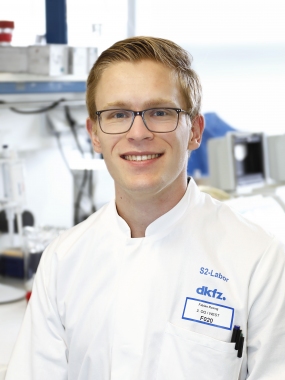
Fabian Rosing
© DKFZ/Jung
Human papillomavirus (HPV) infections have in the past been mostly associated with cervical cancer. In recent years, however, many developed countries have seen a strong and steady increase in HPV-driven oropharyngeal cancer (OPC), now being the most common HPV-associated cancer in some countries. Even though HPV-driven OPC has a better prognosis than HPV-negative (i.e., mostly smoking-driven) OPC, treatment often comes with severe long-term side effects for the patient. This is in part explained by its tendency to form lymph node metastases early on, making aggressive treatment regimens necessary. To reduce treatment-related morbidity, early detection of HPV-OPC is of highest importance. Effective screening programs have shown a massive impact on cervical cancer incidence rates, but since, contrary to cervical cancer, no pre-cancerous lesions for HPV-driven OPC are known to date, screening is currently not feasible.
Previous work by our group has shown that antibodies against the HPV16 E6 oncoprotein are a very sensitive and specific biomarker for HPV-driven OPC, but since they can be present decades before diagnosis this is primarily useful to estimate the long-term risk of developing HPV-OPC. For personalized risk prediction, an additional marker that provides a more short-term indication of tumor growth is necessary. One candidate for this is circulating tumor DNA from blood plasma (ctDNA). Detection of HPV DNA in plasma has been utilized in therapy surveillance of HPV-driven OPC, but little is known about its characteristics before onset of disease. The goal of my project is therefore to detect HPV ctDNA and to assess its dynamics before onset of disease to assess its potential as a biomarker for use in HPV-OPC screening.

© F. Rosing
Figure: Liquid biopsy. Tumors are in contact with the blood stream and shed different materials into it. Tumor cells can enter the blood stream, becoming circulating tumor cells, which play a role in metastasis. Dying tumor cells release DNA into the blood, which can be detected using highly sensitive methods.
Epstein-Barr virus and the risk of nasopharyngeal carcinoma
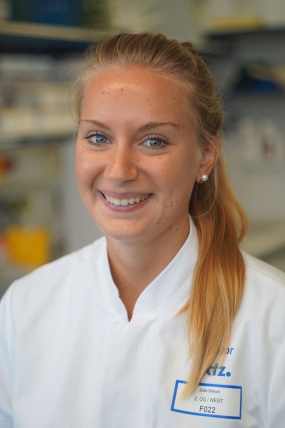
Julia Simon
© DKFZ/Bender
Nasopharyngeal carcinoma (NPC) is a head and neck cancer which is endemic in Southeast Asia, Southern China, North Africa and the Arctic. In endemic regions, NPC is uniformly associated with Epstein-Barr virus (EBV) infection. Although the majority of the world's population is infected with EBV, only a small fraction develops NPC. IgA antibodies against the viral capsid antigen (VCAp18) and Epstein-Barr nuclear antigen 1 (EBNA1) have been shown to be particularly frequent in NPC patients, rather than in healthy EBV-infected individuals, and have been investigated for NPC screening approaches in endemic areas for many decades.
Outside of endemic regions, e.g. in America and Europe, NPC are rare and have been shown to be attributable to EBV infection in only ~65% of the cases. Human papillomavirus (HPV) infection and smoking have been shown to be additional risk factors for NPC development.
To characterize EBV antibodies in sera from NPC patients in both, endemic and low-incidence regions, we have adapted a novel antibody risk stratification signature for multiplex serology.1 The extended EBV antigen panel (n=13) allows a broad characterization of IgA and IgG antibodies, and considerably expands the range of antibodies investigated in the last decades of EBV serology.
Research in low incidence regions is mainly focusing on NPC etiology, including EBV-positive, HPV-positive and EBV/HPV-negative NPC, their characteristics and survival differences.2 In high incidence regions, we focus on serology with novel IgG markers. Those novel serum biomarkers, which are specific for EBV-positive NPC, and not just for EBV-infection, could improve future screening approaches in endemic regions and contribute to early diagnosis and prolonged survival of NPC patients. We aim to apply promising biomarkers from case/control studies in prospective studies, to evaluate their use for the prediction of incident NPC.
1. Simon J, Brenner N, Reich S, Langseth H, Hansen BT, Ursin G, Ferreiro-Iglesias A, Brennan P, Kreimer AR, Johansson M, Pring M, Nygard M, Waterboer T. Nasopharyngeal carcinoma patients from Norway show elevated Epstein-Barr virus IgA and IgG antibodies prior to diagnosis. Cancer Epidemiol. 2022 Apr;77:102117.
2. Simon J, Schroeder L, Ingarfield K, Diehl S, Werner J, Brenner N, Liu Z, Pawlita M, Pring M, Butt J, Ness A, Waterboer T. Epstein-Barr virus and human papillomavirus serum antibodies define the viral status of nasopharyngeal carcinoma in a low endemic country. Int J Cancer. 2020 Jul 15;147(2):461-471.
3. Lam WKJ, King AD, Miller JA, Liu Z, Yu KJ, Chua MLK, Ma BBY, Chen MY, Pinsky BA, Lou PJ, Woo JKS, Hsu WL, Simon J, Doolan DL, Waterboer T, Hui EP, Li H, Tsang RK, Wong KCW, Goh JP, Vlantis AC, Ai QY, Wong LM, Abdullah V, Lin JC, Chen CJ, Pfeiffer RM, Le QT, Lee AWM, Ji M, Cao S, Ma J, Chan ATC, Chan KCA, Hildesheim A. Recommendations for Epstein-Barr virus-based screening for nasopharyngeal cancer in high- and intermediate-risk regions. J Natl Cancer Inst. 2023 Feb 1:djad012.

© J. Simon
Figure: Risk factors for nasopahryngeal carcinoma (NPC) development. Epstein-Barr virus and human papillomavirus are two among many other risk factors, contributing to NPC development.
Nucleic acid detection of infectious agents as potential molecular biomarkers improving early detection of cancer

Daniela Höfler
© DKFZ/Jung
The development of malignant lesions after exposure to carcinogenic pathogens typically requires incubation times between years and decades, opening a wide diagnostic window before clinical cancer diagnosis. The aim of secondary prevention of infection-associated cancers is to identify asymptomatic individuals with precancerous lesions or early stage cancer. Consequently, early detection can reduce cancer incidence and/or mortality, and post-treatment morbidity. Secondary prevention often entails screening for biomarkers in minimally invasive liquid biopsies such as oral gargle samples, swabs or blood. An ideal screening test does not result in overdiagnosis and overtreatment (high specificity), and makes at the same time sure that only very few people with the disease remain undetected (high sensitivity).
About 20% of all cancer cases worldwide are associated with infections. We develop quantitative assays detecting nucleic acids of different infectious agents, including HPV, EBV, STIs such as C. trachomatis, and H. pylori. This includes the establishment of automated nucleic acid extraction protocols from different liquid biopsies, and the amplification and detection by quantitative PCR, digital PCR or multiplex PCR combined with Luminex-based hybridization.
The following assays are currently developed and validated:
- Quantification of human papillomavirus (HPV) DNA in plasma and oral gargles by digital PCR as potential molecular biomarkers for early detection of HPV-driven oropharyngeal cancer
- Quantification of spliced HPV RNA patterns in routine cervical swabs by multiplex RT-qPCR as triage marker for HPV DNA positive women to identify the subset of women that require treatment (Figure)1
- Quantification of HPV DNA and RNA in different liquid biopsies in order to improve the detection of high grade anal precursor lesions with increased likelihood to progress to cancer
- Quantification of Epstein-Barr virus (EBV) DNA and RNA by multiplex RT-qPCR to investigate tumor etiology and EBV attributable fractions of multiple cancers in large epidemiological studies
- Detection of sexually transmitted infections (STI)2 in urine by multiplex PCR/Luminex hybridization in order to improve prostate cancer screening
- Identification of non-pylori Helicobacter DNA in the human gastro-intestinal tract by multiplex PCR/Luminex hybridization to estimate its relevance in carcinogenesis3
1. Höfler D, Böhmer G, von Wasielewski R, Neumann H, Halec G, Holzinger D, Dondog B, Gissmann L, Pawlita M, Schmitt M. HPV16 RNA patterns defined by novel high-throughput RT-qPCR as triage marker in HPV-based cervical cancer precursor screening. Gynecol Oncol. 2015; 183(3):676-82.
2. Schmitt M, Depuydt C, Stalpaert M, Pawlita M. Bead-based multiplex sexually transmitted infection profiling. J Infect. 2014; 69(2):123-33.
3. Butt J, Schmitz M, Berkus B, Schmidt K, Höfler D. Validation of multiplex PCR and serology detecting Helicobacter species in mice. Microorganism 2023, 11(2): 249.

© D. Höfler
Figure. HPV16 RNA patterns positivity in 158 singly HPV16 DNA-positive cervical lesions of different grades. HPV RNA1/RNA2 ratio-positive only (grey bars), HPV RNA3-positive only (white bars) and the RNA1/RNA2 ratio- and RNA3-positive patients (black bars) diagnosed as no intraepithelial lesion or malignancy (NIL/M, n = 36), cervical intraepithelial neoplasia grade 0 (CIN0, n = 11) and CIN1 (n = 11), combined in the ≤CIN1 category (n = 58), and as CIN3 (n = 41) and CxCa (n = 18), combined in the ≥CIN3 category (n = 59). RNA1= HPV16 E6*I, RNA2= HPV16 E1^E4, RNA3= HPV16 E1C.
Serology of bacteria and gastrointestinal cancer risk
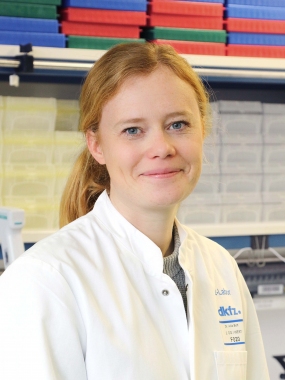
Dr. Julia Butt
© DKFZ/Jung
Cancers of the stomach and colorectum together accounted for almost 2 million new cases in 2020 worldwide. The major risk factor for development of stomach cancer is infection with the bacterium Helicobacter pylori (H. pylori). In case of colorectal cancer, research of the recent decades also focused on an association with bacterial infections. Studies addressing more specifically individual bacterial species identified Streptococcus gallolyticus subsp. gallolyticus (S. gallolyticus), Fusobacterium nucleatum (F. nucleatum), enterotoxigenic Bacteroides fragilis (ETBF), genotoxic Escherichia coli (E. coli), as well as H. pylori of potentially being associated with colorectal cancer. However, there is a lack of prospective data for the observed associations, which is relevant for the identification of risk markers for colorectal cancer development. Thus, we aim to fill this knowledge gap by applying serological assays in colorectal cancer case-control studies nested within large prospective cohorts (Figure 1). Our group developed multiplex serology assays for the detection of above described bacteria, and assessed the association of antibody responses to these in collaboration with large epidemiological studies including the European Prospective Investigation into Nutrition and Cancer (EPIC) and a consortium of 10 prospective cohorts in the United States.1, 2, 3, 4
Moreover, as mentioned above, the association of H. pylori with stomach cancer is well-established, however, this refers only to traditional-onset stomach cancers diagnosed at age 50 years or older. Recently, an increase in incidence of young-onset stomach cancer (< 50 years) has been described and risk factors for this subset of stomach cancers are not yet clear. We are interested in expanding our serological biomarker studies to young-onset gastric cancer, with a focus on H. pylori infection as well as autoimmune gastritis. In collaboration with the Finnish Maternity Cohort we were able to demonstrate that indeed H. pylori and autoimmune gastritis, depending on the histological classification of the cancer, are associated not only with risk of developing traditional- but also young-onset stomach cancer.5
1. Butt J, Jenab M, Willhauck-Fleckenstein M, Michel A, Pawlita M, Kyrø C, Tjønneland A, Boutron-Ruault MC, Carbonnel F, Severi G, Kaaks R, Kühn T, Boeing H, Trichopoulou A, la Vecchia C, Karakatsani A, Panico S, Tumino R, Agnoli C, Palli D, Sacerdote C, Bueno-de-Mesquita HBA, Weiderpass E, Sánchez MJ, Bonet Bonet C, Huerta JM, Ardanaz E, Bradbury K, Gunter M, Murphy N, Freisling H, Riboli E, Tsilidis K, Aune D, Waterboer T, Hughes DJ. Prospective evaluation of antibody response to Streptococcus gallolyticus and risk of colorectal cancer. Int J Cancer. 2018;143(2):245–252.
2. Butt J, Varga MG, Blot WJ, Teras L, Visvanathan K, Le Marchand L, Haiman C, Chen Y, Bao Y, Sesso HD, Wassertheil-Smoller S, Ho GYF, Tinker LE, Peek RM, Potter JD, Cover TL, Hendrix LH, Huang LC, Hyslop T, Um C, Grodstein F, Song M, Zeleniuch-Jacquotte A, Berndt S, Hildesheim A, Waterboer T, Pawlita M, Epplein M. Serologic Response to Helicobacter pylori Proteins Associated With Risk of Colorectal Cancer Among Diverse Populations in the United States. Gastroenterology. 2019;156(1):175–186.e2.
3. Butt J, Jenab M, Pawlita M, Overvad K, Tjonneland A, Olsen A, Boutron-Ruault MC, Carbonnel F, Mancini FR, Kaaks R, Kühn T, Boeing H, Trichopoulou A, Karakatsani A, Palli D, Pala VM, Tumino R, Sacerdote C, Panico S, Bueno-de-Mesquita B, van Gils CH, Vermeulen RCH, Weiderpass E, Quirós JR, Duell EJ, Sánchez MJ, Dorronsoro M, Huerta JM, Ardanaz E, Van Guelpen B, Harlid S, Perez-Cornago A, Gunter MJ, Murphy N, Freisling H, Aune D, Waterboer T, Hughes DJ. Antibody Responses to Fusobacterium nucleatum Proteins in Prediagnostic Blood Samples are not Associated with Risk of Developing Colorectal Cancer. Cancer Epidemiol Biomarkers Prev. 2019;28(9):1552–1555.
4. Butt J, Jenab M, Werner J, Fedirko V, Weiderpass E, Dahm CC, Tjønneland A, Olsen A, Boutron-Ruault MC, Rothwell JA, Severi G, Kaaks R, Turzanski-Fortner R, Aleksandrova K, Schulze M, Palli D, Pala V, Panico S, Tumino R, Sacerdote C, Bueno-de-Mesquita B, Van Gils CH, Gram IT, Lukic M, Sala N, Sánchez Pérez MJ, Ardanaz E, Chirlaque MD, Palmquist R, Löwenmark T, Travis RC, Heath A, Cross AJ, Freisling H, Zouiouich S, Aglago E, Waterboer T, Hughes DJ. Association of Pre-diagnostic Antibody Responses to Escherichia coli and Bacteroides fragilis Toxin Proteins with Colorectal Cancer in a European Cohort. Gut Microbes 2021;13(1):1-14.
5. Butt J, Lehtinen M, Öhman H, Waterboer T, Epplein M. Association of Helicobacter pylori and Autoimmune Gastritis With Stomach Cancer in a Cohort of Young Finnish Women. Gastroenterology. 2022;163(1):305-307 e4.

© J. Butt
Bacterial infections associated with cancer: Whole-proteome microarrays for antigenic target identification
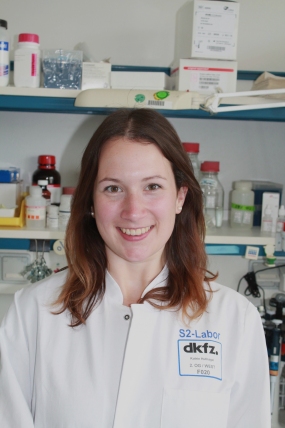
Katrin Hufnagel
© dkfz.de
Published whole-proteome microarrays to systematically investigate the humoral immune response to bacterial infectious agents were so far based on individual cloning, expression and purification of hundreds or thousands of bacterial open reading frames. To overcome this limitation, and to maintain at the same time the advantages of slide-based microarrays, we have developed a novel method to generate microarrays representing an entire bacterial proteome, using Chlamydia trachomatis (Ct) as a complex model organism. It is based on a combination of multiple spotting technique and on-chip in situ protein expression. Expression constructs for each individual bacterial protein were generated by two successive PCRs using bacterial genomic DNA as a template, and proteins were expressed directly on microarray slides. We performed proteome immunoassays by incubating clinically characterized sera of Ct infected patients onto the whole-proteome arrays, and were able to provide evidence of antibody reactivity patterns that represent either Ct exposure markers, markers associated with persistent infections, or Ct associated cervical cancer markers (Figure). De novo identified antigens were validated in a large population-based cervical cancer case control study using high-throughput suspension bead array serology. The combination of high-density, low-throughput proteome immunoassays and low-density, high-throughput suspension bead array serology is a powerful platform for the discovery of exposure and disease-specific biomarkers and can be easily adapted to other microorganisms in all areas of infection research as well as in e.g. autoantibody screening and epitope mapping.
1. Hufnagel K, Lueong S, Willhauck-Fleckenstein M, Hotz-Wagenblatt A, Miao B, Bauer A, Michel A, Butt J, Pawlita M, Hoheisel JD, Waterboer T. Immunoprofiling of Chlamydia trachomatis using whole-proteome microarrays generated by on-chip in situ expression. Sci Rep. 2018 May 14;8(1):7503.
2. Hufnagel K, Hoenderboom B, Harmel C, Rohland JK, van Benthem BHB, Morré SA, Waterboer T. Chlamydia trachomatis Whole-Proteome Microarray Analysis of The Netherlands Chlamydia Cohort Study. Microorganisms. 2019 Dec 16;7(12):703.
3. Liu C, Hufnagel K, O'Connell CM, Goonetilleke N, Mokashi N, Waterboer T, Tollison TS, Peng X, Wiesenfeld HC, Hillier SL, Zheng X, Darville T. Reduced Endometrial Ascension and Enhanced Reinfection Associated With Immunoglobulin G Antibodies to Specific Chlamydia trachomatis Proteins in Women at Risk for Chlamydia. J Infect Dis. 2022 Mar 2;225(5):846-855.
Results of Proteome Immunoassays (PIA) using pools of five sera

© K. Hufnagel
Figure: In total 897 Ct proteins were spotted on one array. Sera from uninfected women did not show positive signals with any of the Ct proteins, while all serum pools of Ct-infected women revealed positive signals. Comparison of the antibody reactivity patterns identified antigens which reacted with all Ct seropositive pools but also antigens which reacted only with serum pools from cancer patients. Some antigens reacted only with pools of sera from women of higher age, possibly indicating persistent Ct infections. Examples for antigens associated with general Ct infections, potentially persistent infections and cervical cancer are highlighted in green, yellow, and blue boxes, respectively.
De novo identification of serological H. pylori biomarkers linked to gastric cancer
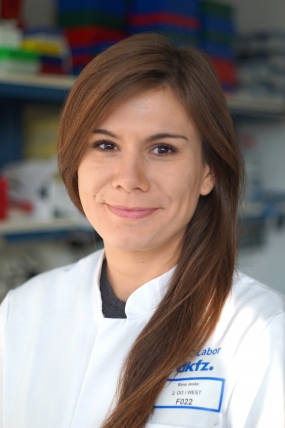
Rima Jeske
© DKFZ/Jung
Infection with the highly prevalent bacterium Helicobacter pylori is the leading risk factor for gastric cancer. Yet, only a minority of infected individuals experience symptoms and even fewer eventually develop the neoplasia.
Stratifying individuals into personalized risk groups is a desirable strategy to implement secondary prevention for gastric cancer, e.g. based on serological assays. Antibodies against the virulence factor CagA are considered a promising risk marker in some parts of the world. In other parts, however, seropositivity for CagA antibodies is too frequent to enable efficient risk stratification. Hence, additional serological biomarkers are highly desired.
To enable an unbiased de novo identification, we adapted our established method for Chlamydia trachomatis and displayed the proteome (1,442 proteins) of H. pylori strain 26695 on high-density microarrays. To identify antibodies associated with gastric cancer, we analyzed sera from patients and their matched controls from a European case-control study on our antigen microarrays. Results confirmed existing biomarkers (especially CagA antibodies) and also revealed new candidates, such as HopA. Their potential to discriminate between gastric cancer cases and controls is being evaluated in large seroepidemiological studies using our high-throughput Multiplex Serology platform.
Recently, we advanced the H. pylori microarray further by including genes from additional H. pylori isolates generating a non-redundant set of 1,833 proteins. Hereby, we aim to create a universal platform that can be used to detect new biomarkers regardless of the analyzed cohort, population or outcome. This H. pylori multi-strain microarray is currently being used to identify serological biomarkers for non-cardia gastric cancer in two seroepidemiological studies from China.
1. Hufnagel K, Lueong S, Willhauck-Fleckenstein M, Hotz-Wagenblatt A, Miao B, Bauer A, Michel A, Butt J, Pawlita M, Hoheisel JD, Waterboer T. Immunoprofiling of Chlamydia trachomatis using whole-proteome microarrays generated by on-chip in situ expression. Sci Rep. 2018 May 14;8(1):7503.
2. Jeske R, Reininger D, Turgu B, Brauer A, Harmel C, Fernández de Larrea-Baz N, Martín V, Moreno V, Kogevinas M, Pollán M, Hoheisel JD, Waterboer T, Butt J, Aragonés N, Hufnagel K. Development of Helicobacter pylori Whole-Proteome Arrays and Identification of Serologic Biomarkers for Noncardia Gastric Cancer in the MCC-Spain Study. Cancer Epidemiol Biomarkers Prev. 2020 Nov;29(11):2235-2242.

© R. Jeske
Figure: H. pylori microarray displaying the non-redundant proteome (n = 1,833) of the five different H. pylori strains (including the common reference strain 26695). Determination of on-chip expression by dual anti-tag staining. Green signals derive from the anti-V5 (N-terminal) signal, while red signals derive from the anti-6xHis (C-terminal) antibody. Merged signals appear yellow. Negative controls (n = 119) are distributed across the slide. A successful expression was verified for up to 94% of the proteins.
SARS-CoV-2 serolomics

Julia Butt
© DKFZ/Jung
We are only at the beginning of understanding the epidemiology of the worldwide COVID-19 pandemic. Assessing SARS-CoV-2 seroprevalence in large population-based studies, the evolution of antibody development over time after natural infection and/or vaccination, secondary attack rates after household infection, or the importance of antibodies to non-structural proteins, is of high importance to better understand outcomes such as acute disease severity, re-infection, or the occurrence of Long COVID.
We developed a multiplex serology assay covering almost the entire SARS-CoV-2 proteome (SARS-CoV-2 serolomics). Seropositivity to structural proteins N and S1-RBD yielded sensitivities and specificities of both 100% in detecting COVID-19 positive patients 14 days after symptom onset in a German hospital-based study (Figure 1).1 This assay is currently applied in multiple studies of national and international collaborations to answer the above-mentioned open questions. The multiplex ability of this assay moreover allows including antigens of different SARS-CoV-2 variants of concern, human "common cold" coronaviruses, and other pathogens including human herpesviruses that have been hypothesized to affect long-term outcomes of COVID-19 disease.
To allow for efficient high-throughput analyses of COVID-19 epidemiological studies, the SARS-CoV-2 serolomics assay will be integrated into a recently established automated workflow.
1. Butt J, Murugan R, Hippchen T, Olberg S, van Straaten M, Wardemann H, Stebbins E, Kräusslich HG, Bartenschlager R, Brenner H, Laketa V, Schöttker B, Müller B, Merle U, Waterboer T. From Multiplex Serology to Serolomics-A Novel Approach to the Antibody Response against the SARS-CoV-2 Proteome. Viruses. 2021 Apr 24;13(5):749.

© J. Butt
Figure 1: Longitudinal antibody responses to SARS-CoV-2 structural proteins N and S1-RBD in COVID-19 patients of a German hospital-based study. After 14 days post symptom onset all patients seroconverted to both proteins.1
